If you are involved in a multisite church or are considering becoming one, you have probably asked the question, “Well, how are other multisite churches doing it?”
As part of a multisite church and a campus pastor, that question provoked me to find out exactly how other multisite churches are operating?
MultiSite Church Trends
Multisite Church Trends Post-Pandemic Era
Multisite churches are not going away, even in the post-pandemic era. The Leadership Network released the latest multisite trends as of 2018, and out of 1500 + participants, 83% of pastors under age 40 plan to launch multiple campuses.[3]
Below are recent comments from Michael Todd about their decision to remain online and the results.
I am preaching in an arena that seats 4,500 people with less than 10 people in it every week. But it is real to the end-user. And so if I get out of how it makes me feel and nobody’s hollering back at me or nobody’s clapping at that moment what ends up happening is, the people are still getting touched, they’re getting help, they’re getting healed.
They’re finding all of the answers that they’re looking for in a live experience. And there is no way that we could have fit the number of people that we reached last week into our building if we had 20 services. – careynieuwhof.com
The benefits of going multisite are exciting and attractive. The span of reach extends, and doing so opens opportunities for ministry in rural and even niche areas. By nature, it also demands a leadership development process that affords a growth path for young leaders.

COVID-19 did not change the multisite trends we were already seeing pre-pandemic, but rather, it accelerated them. – theunstuckgroup.com
The idea of micro-sites is even gaining ground—missional small group and campus feeder strategy to extend the reach of a church.
Microsites meet in homes, retirement centers, homeless shelters, bars, gyms, clubs, businesses—any place a small group can gather. The gathering functions as more than a small group but less than a full congregation.[4]
The potential to create new avenues of bringing the church to communities is greater than ever before. Combining God’s mission, passionate creativity, and technology is helping break the mold from traditional models of providing church.
Below you’ll find insight into how larger and smaller churches in rural and populated areas are navigating the tension between central and campus staff, replicating experiences and structuring their team.
Before we jump into the research, there are a few terms you should be familiar with:
MultiSite Church Terms
Central Support: Ministry specific directors who resource and train campus ministry leaders
Campus Staff: Leaders who execute specific ministry at a campus level
Location/Campus Pastor: Campus-specific pastor who champions to DNA of the church, builds teams, and shepherds the people.
Centralized: Higher levels of control of what happens across campuses
Decentralized: Level of freedom campus-level leaders receive to express the mission of the church

MultiSite Church Staffing Spectrum
Multisite from a leadership perspective typically lives on a scale with two opposite poles: High Control on one end and Autonomy on the other.
Of the churches I directly spoke with and based additional research on, it seems that most churches are navigating what it means to operate somewhere between a high-control environment and an autonomous one.
To be more concise about multisite intentions, I have labeled some of the graphics below as “Ability To Replicate Campus Experiences.”
The differences between a high control and autonomous model of multisite commonly hinge upon whether or not there is a live preaching or a live stream (or pre-recorded).
Tony Morgan has said, “If it’s not on a screen, it’s not multisite.” [1]
High Control: Live-Stream
Autonomy: Live Preaching
While this is one example of the differences, there are more.
High Control: Finances of individual campuses are managed by central
Autonomy: Financial management is a campus level
High Control: Layers of Communication and Structure
Autonomy: Minimal Lines of Communication
High Control: Central Leadership Team
Autonomy: Campus Specific Leadership Team
High Control: One Elder Team
Autonomy: Campus Specific Elder Teams
Suppose the goal is to be “one church, multiple locations” meaning, an evident and intentional duplication of values, culture, aesthetics, and mission. In that case, it is dangerous to lean too far toward campus autonomy.
On the autonomous side, as you can see, there is more room for campuses to develop distinct, individualistic qualities rather than sharing them.
Most multisite churches do not become autonomous campuses with that goal in mind. Although, because of the effort, communication, and structure required to maintain a thriving multisite church, drifting toward Autonomy can quickly happen.
Navigating Central And Campus Level Support For Multisite Churches
The majority of multisite churches are structuring their leadership somewhere in-between a central and decentralized strategy. Some are weighted heavier toward one side, which will always be the case. However, keep in mind, depending on where a church lands on the scale will determine its ability to Replicate A “Look-A-Like Campus Experience.
Chris Mavity explains why this tension exists: The challenge is that many senior pastors are not astute at decentralized organizational constructs. This is not how they were trained. Over the years, they grew their ministry with a centralized leadership model.
As the senior leader of the originating site, there was good growth. But a centralized approach bogs down when adding more and more campuses. Developing a strong decentralized model of leadership fuels more creativity, development, and, ultimately, growth.[2]
Senior pastors should be quick to strategically empower trusted leaders who can make decisions so that operations can grow while they focus on leading the church into the future.
Chris Goeppner, the lead pastor of River Bank Church, a multisite church of 1000 in weekly attendance in a town of 2500 people in Vermont, developed a centralized team that empowers volunteers (even as Campus Pastors) to lead key areas of ministry at both locations.
To navigate the management spectrum within multisite churches, leaders use different ways of describing how lines keep from becoming blurred.
Frames
Some multisite churches use the term “Frames” to describe the non-negotiables that must be in place at a campus level. For Our Savior’s Church, the “frame” provides boundaries the campus-level ministry team can “paint” within.
For example:
Frame #1: Every campus must offer a new member’s class.
Paint #1: What time these new members class takes place is up to campus-level leaders.
Frame #2: Every campus must use the same sermon series topic.
Paint #2: Each speaker has the freedom to share the topic uniquely.
Our Savior’s Church leadership team practices giving and receiving feedback regularly through multiple layers of leadership to avoid micro-management.
Discipleship eliminates micro-management. – Tim Dilena
They believe the best way to execute high expectations is to build high levels of trust through discipleship.
Campus Constants
One Harbor Church in North Carolina uses a list of things they want the same at every location they call Campus Constants. Some things on the list are concrete, like their vision and mission. Principles and practices guide other areas.
A list like this provides an anchor for each campus while also permitting agreeable amounts of freedom at campus levels. As a result, it is easier to maintain expectations through structured leadership and healthy communication.

MultiSite Church Models & Strategy
Different leadership structures are used to provide accountability, resourcing, and training.
Adding a campus requires lines of communication to grow exponentially. Therefore, the structure must become sophisticated enough to support the organization adequately.
Life.Church led by Craig Groeschel currently steers 32 campuses with the help of a directional leadership team. Life.Church uses a central ministry team to ensure the ministry is replicable because they have campuses all over the United States.
Life.Church assigns an Area Leader to every campus determined by their region. Between the Central Staff and the Area Leaders, onsite campuses provide feedback and ensure ministry replication.
Life.Church Multisite Model
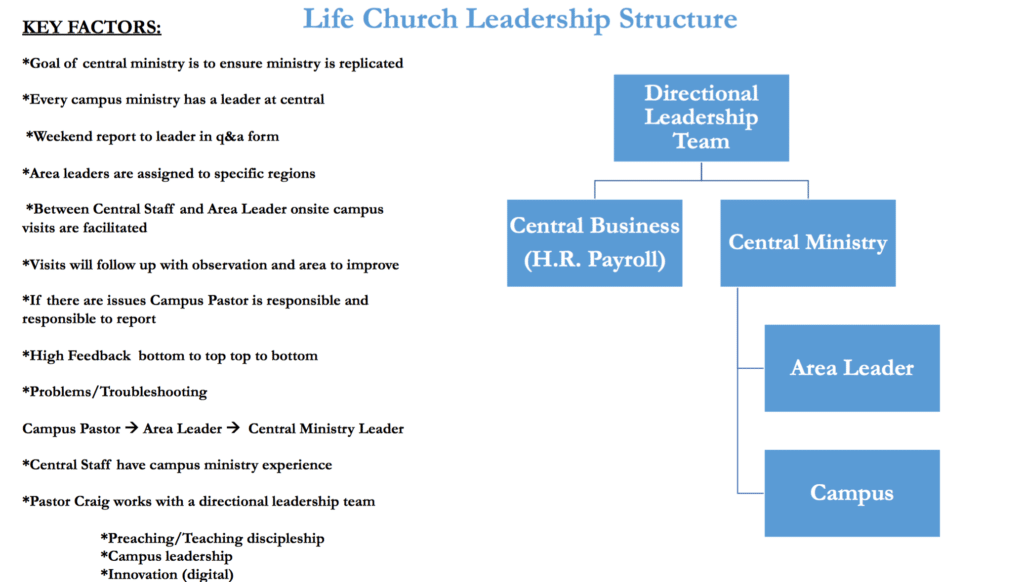
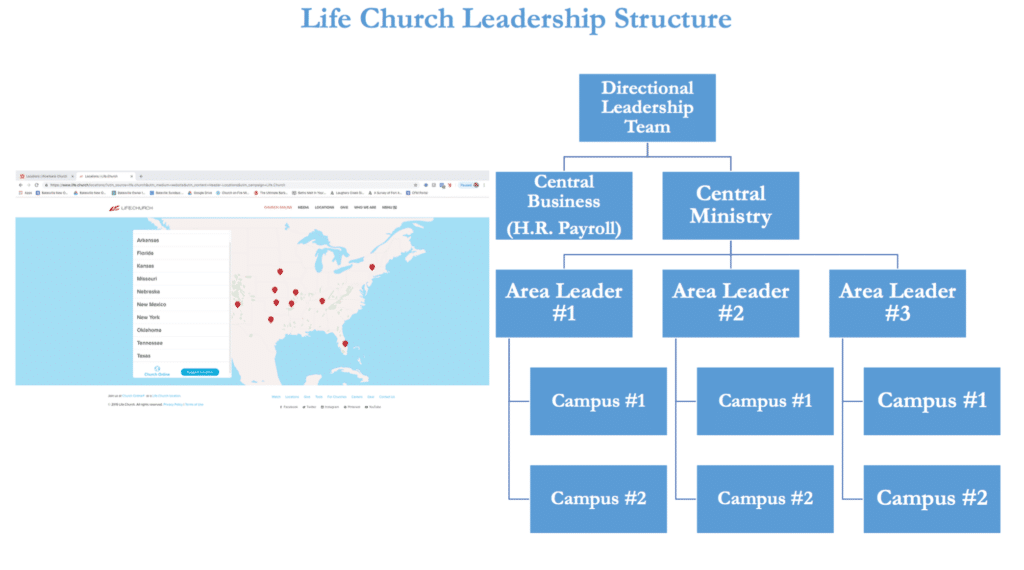
6 Key Principles Of Life.Church Multisite Strategy
- The goal of central ministry is to ensure the ministry is replicable
- Every campus ministry has a leader at central
- Between Central Staff and Area Leader, they facilitate onsite campus visits
- Visits will follow up with observation and area to improve
- High Feedback bottom to top and top to bottom
- Central Staff have campus ministry experience
Our Savior’s Church Multisite Model
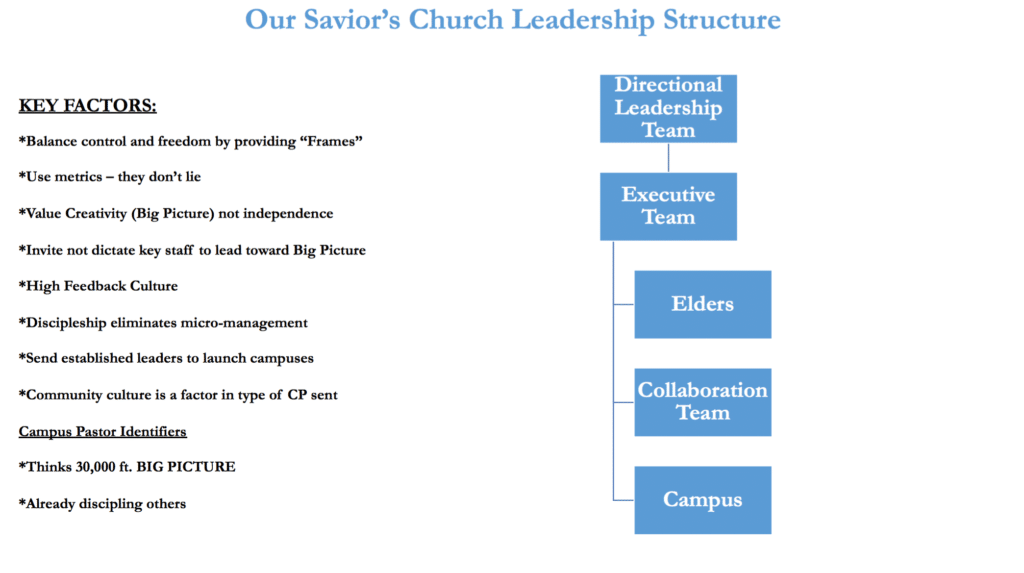
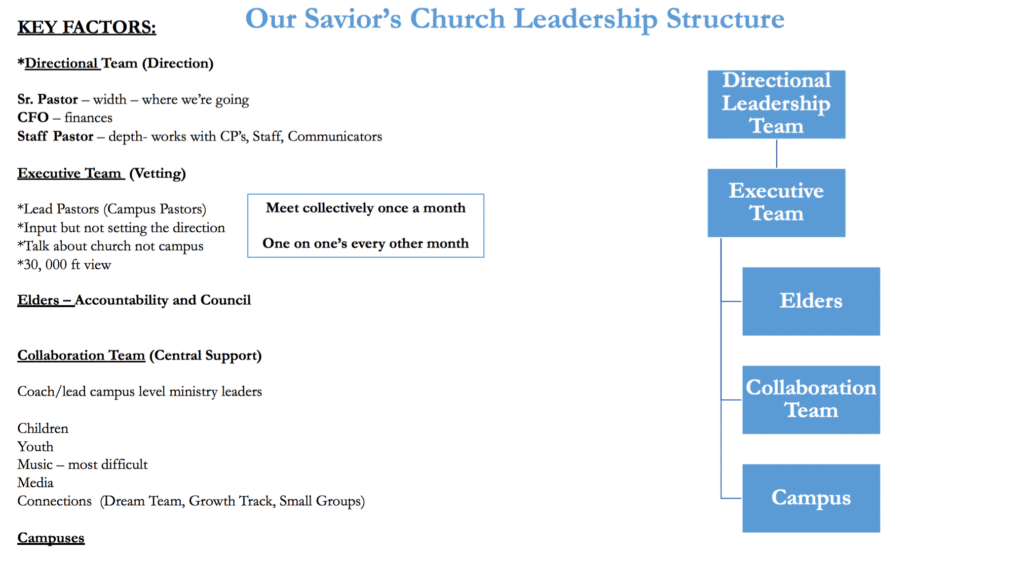
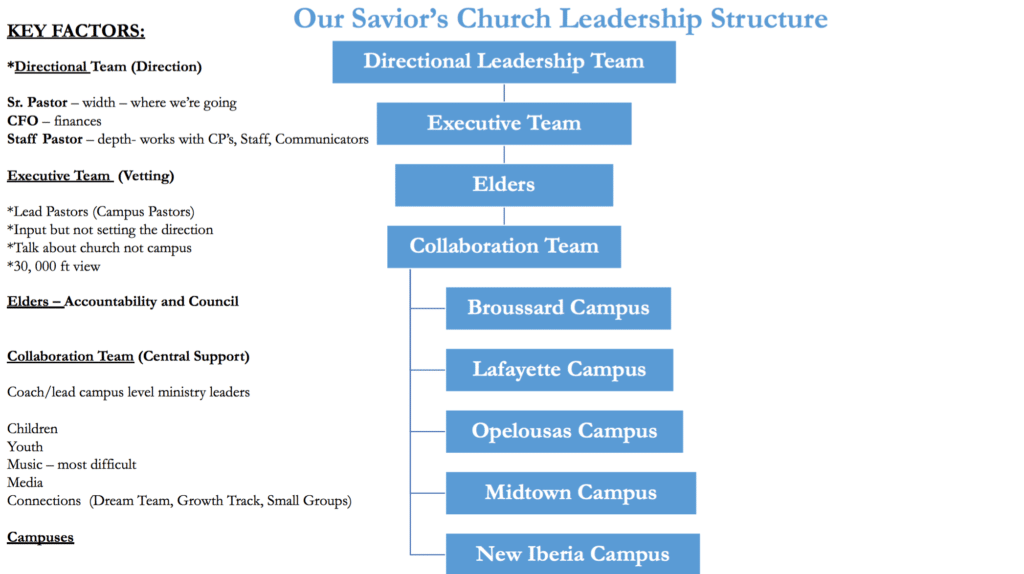
6 Key Principles Of Our Savior’s Church Multisite Strategy
- Balance control and freedom by providing “Frames”
- Use metrics – they don’t lie
- Value Creativity (Big Picture) not independence
- High Feedback Culture
- Discipleship eliminates micro-management
- Send established leaders to launch campuses
River Bank Church Multisite Model
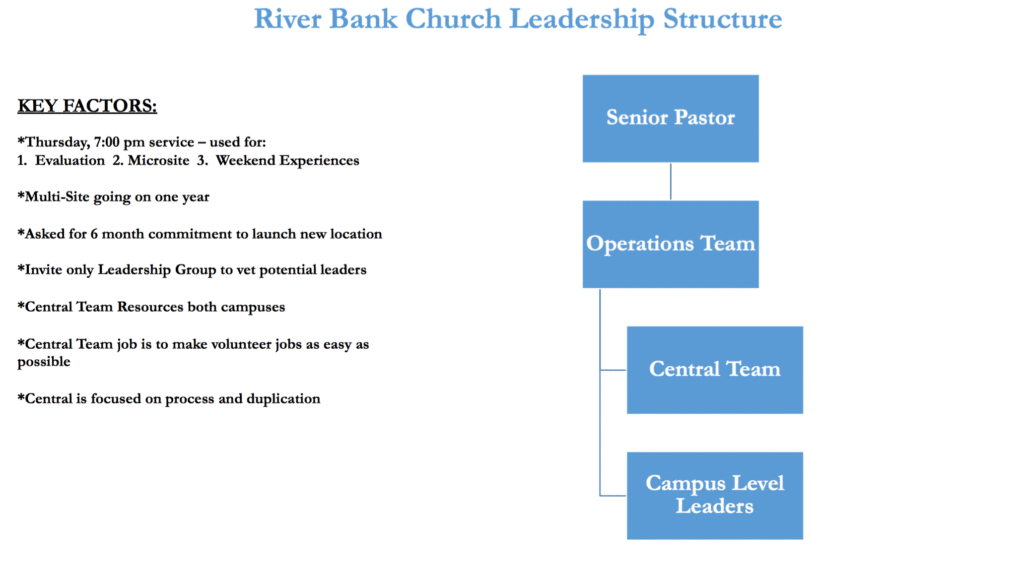
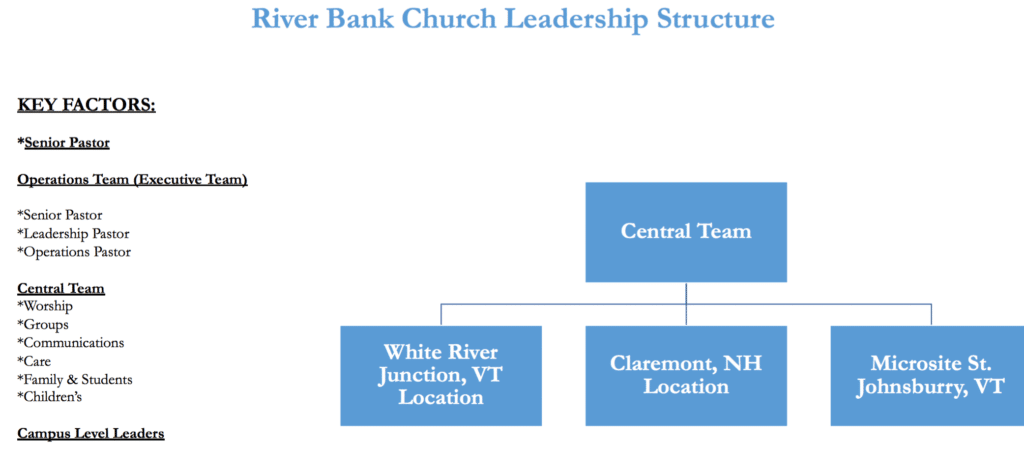
4 Key Principles Of River Bank Church Multisite Strategy
- Asked for a 6-month commitment from launch to help establish the new location
- Central Team resources both campuses
- Central Team’s job is to make volunteer jobs as easy as possible
- The Central Team focuses on process and duplication
Can Multisite Churches Replicate Campus Experiences?
Below is a graph displaying different multisite churches’ abilities to replicate similar campus experiences. Keep in mind this is my own opinion based on critical factors that I deemed essential.
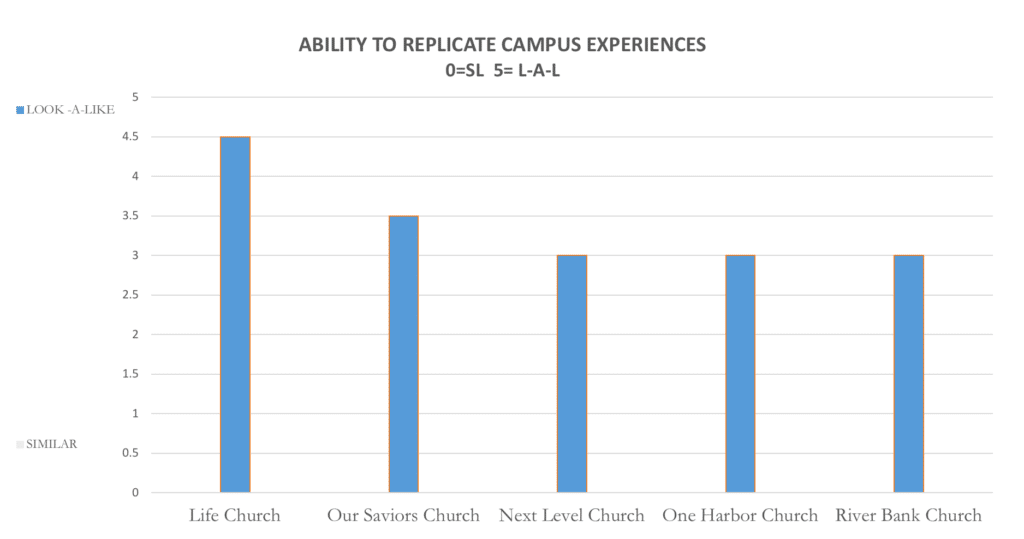
5 Critical Factors Multisite Churches Must Consider To Replicate Campus Experiences Successfully
1. Size Of Additional Campuses
The size of additional campuses compared to the central location is essential because the number of people in a space can significantly impact the dynamics of the experience.
2. Paid Positions Staffed At Time Of Campus Launch
Ideally, paid staff members should produce a greater output than someone who is volunteering. Thus, the number of staffed positions at the campus launch will also influence the ability to replicate a similar campus experience.
3. Live-Stream Or Live Preaching
Having different communicators at different campuses will change how messages are shared and presented while not a bad thing. Therefore, having one communicator share the same message across all campuses allows consistency.
4. Method Of Training Leaders At Multiple Sites
A central team of leaders solely focused on training and resourcing ministry-specific areas should help ensure ministry excellence. In contrast to having one person or a few leaders share and meet expectations.
5. Level Of Centralization And Decentralization
As mentioned above, depending on how much freedom campus-level ministries have “paint within frames” or adhere to “campus constants” will influence experiences from campus to campus.

What Does This Multisite Church Data Mean?
EVERY CHURCH IS DIFFERENT
It seems that those leading multisite churches would tell you that to some degree, they’re still figuring it out.
One of the beautiful things about the Body of Christ is that every church in some ways expresses the character, mission, and heart of God in uniquely different ways.
Thriving multisite churches do share common principles regarding successful multisite ministry; however, it is not cookie-cutter, one size fits all.
One of the most encouraging resources I’ve come across is episode 039 from the Joshua Gagnon Leadership Podcast, The Four Tires That Drive Multisite. You won’t find step-by-step directions for how to lead a multisite church. However, you’ll find tested principles and lessons learned.
Multisite Church Strategies Of 5 Different Churches
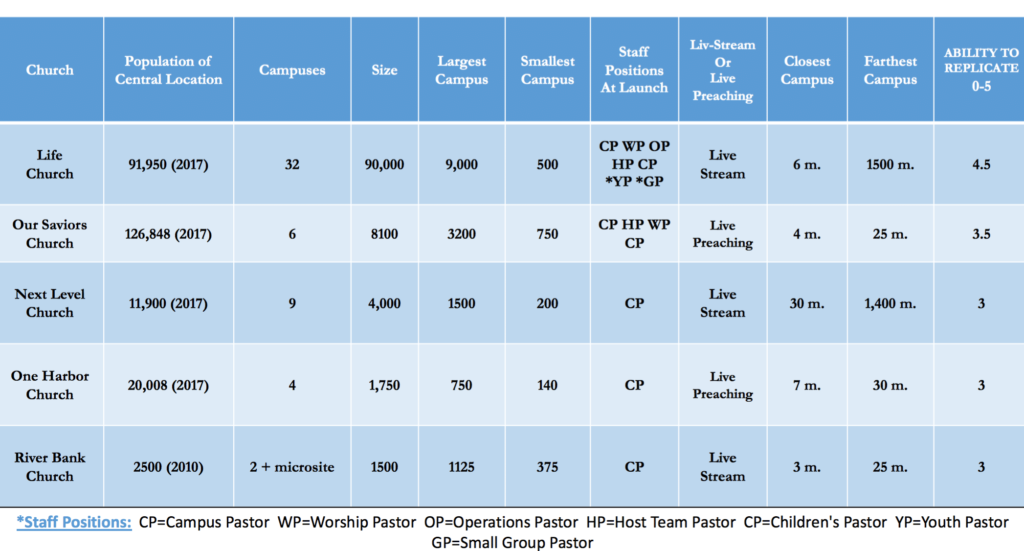
What are the take-aways from the graph above?
- Stop comparing your church to other churches. Every church has unique dynamics related to it, including yours.
- Learn from other churches who are successfully doing multisite. Adopt principles and use guiding questions to determine if and how your church should do multisite.
- Consider the context of your church and the vision in your heart. How do multisite relate to both?
11 Clarifying Questions For Churches Considering Becoming A MultiSite Church
- Is church planting or multisite more in alignment with our vision?
- How much freedom and control do we want campuses to have?
- What are the constants (FRAMES) that must be in place?
- What does Central Support Staff vs. Campus Ministry mean to us?
- Are additional layers of leadership necessary?
- Which positions are staffed positions at the time of campus launch?
- Will campuses operate financially independently or share resources?
- What measures will be used to determine how campuses are resourced if funds are shared?
- Is there a minimum number of people we want to launch a new campus with?
- What is our strategy for developing campus-level leaders?
- What is our strategy for launching additional campuses?
Additional Multisite Church Resources
Below are several helpful resources that are far more versed in multisite. If you are not already familiar with them, I highly encourage you to subscribe, read and follow.
Carey Nieuwhof Leadership Podcast
Craig Groeschel Leadership Podcast
Joshua Gagnon Leadership Podcast
Thank You!
Thanks to each leader involved from the following churches for the helpful multisite church conversations and resources! May God continue to bless your ministries and use them to encourage other leaders.
Multisite Church Sources
[1] https://tonymorganlive.com/2017/08/24/best-multisite-church-models/
[2] https://www.xpastor.org/strategy/multi-site/the-structure-of-multisite-leadership-teams/
[3] http://leadnet.org/download/multisite-latest-trends-2018/
[4] https://multisitesolutions.com/microsites-new-big/


